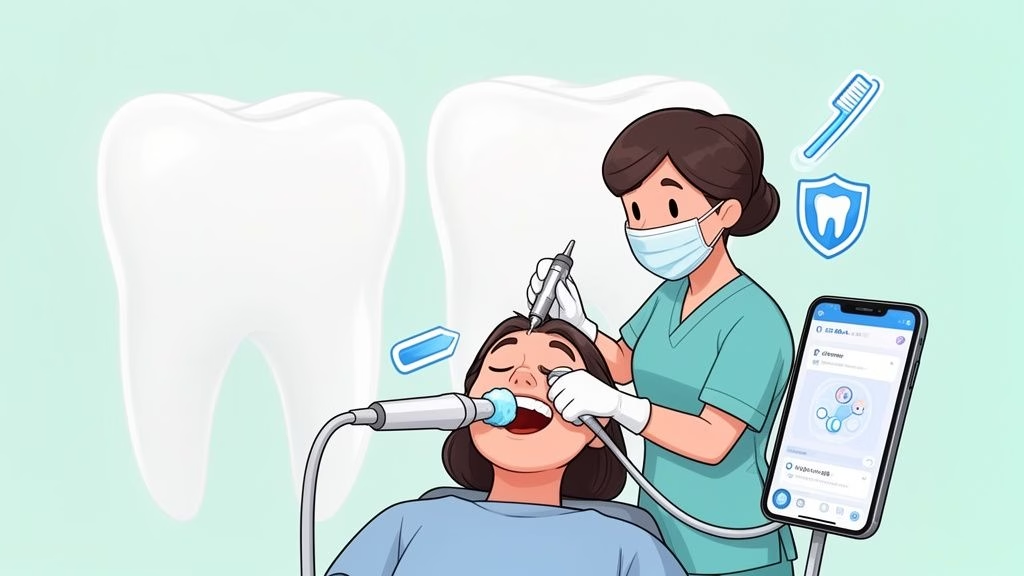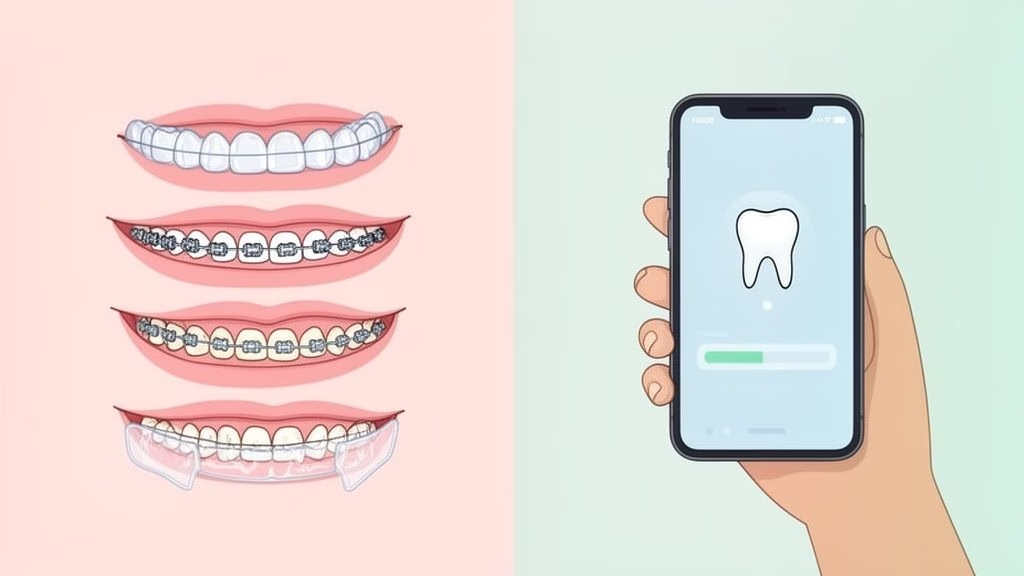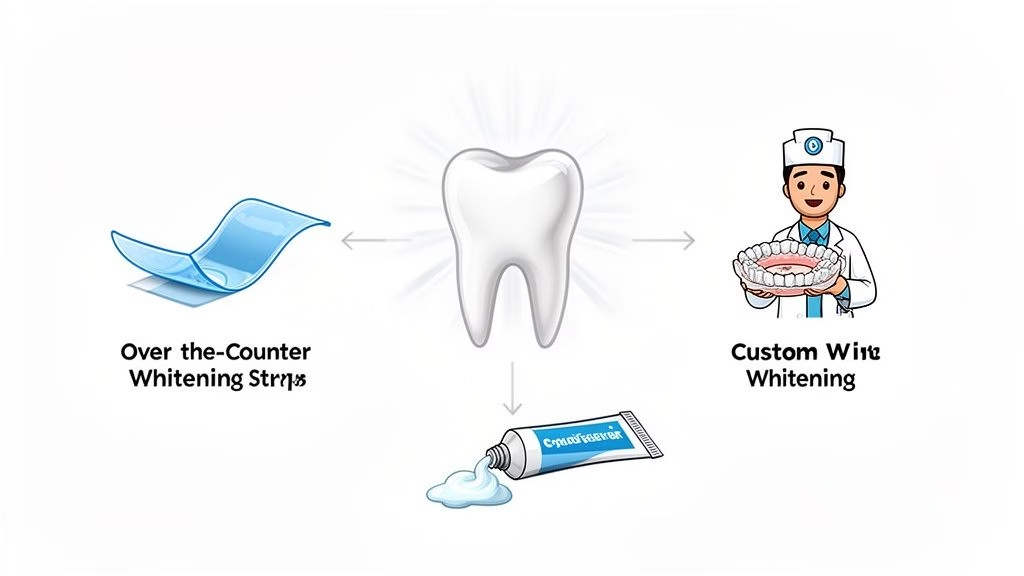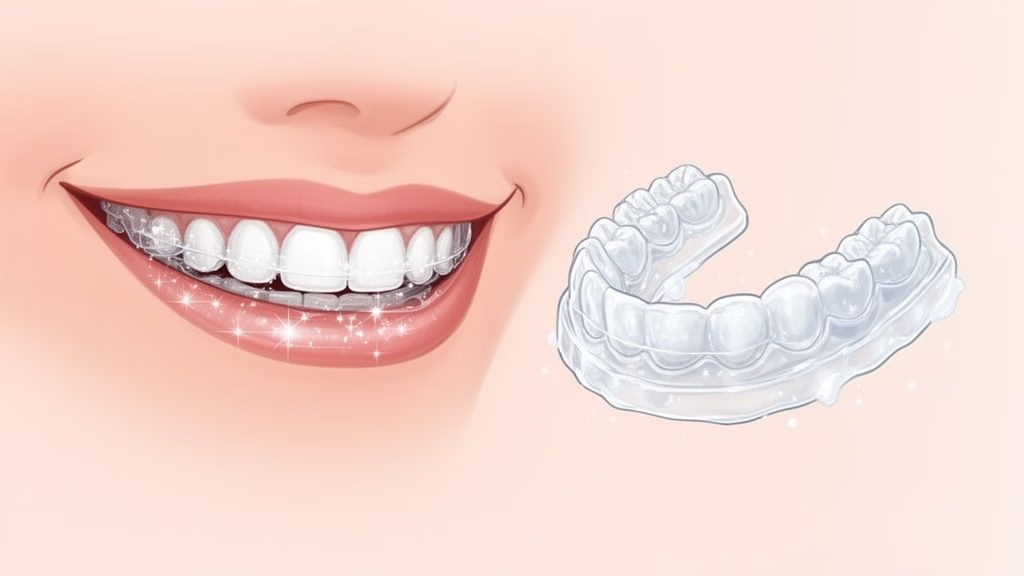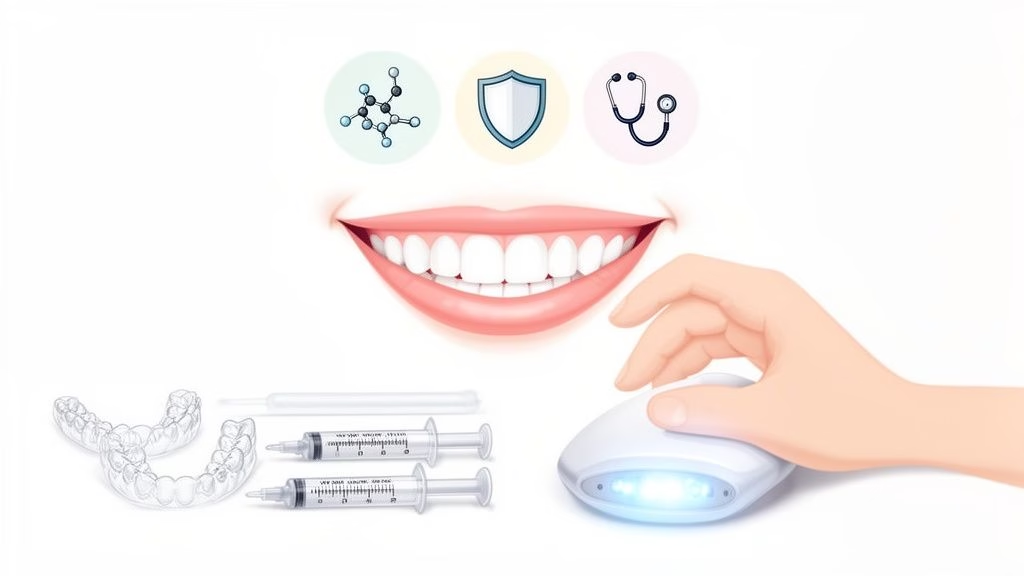UK Guide to Invisible Braces for Adults

Let’s be honest, the thought of straightening your teeth as an adult can be daunting. For many, it brings up images of traditional metal braces – something most of us would rather leave behind in our teenage years. But what if you could achieve a straighter, healthier smile without anyone even noticing?
That’s the promise of modern invisible braces. These aren’t your old-school ‘train tracks’. We’re talking about clever, discreet orthodontic solutions, like clear aligners, that are designed specifically for adult lifestyles. They let you work towards the smile you’ve always wanted, subtly and on your own terms.
The Modern Way to Straighten Adult Teeth
For a long time, if you were an adult who wanted straighter teeth, you had a tough choice to make. You could either live with your smile as it was or commit to a mouthful of very noticeable metal wires and brackets. For most professionals, that was a non-starter.
This is exactly why invisible braces have been such a game-changer in adult orthodontics. The whole field has moved on from clunky, fixed hardware to discreet, convenient options that fit right into a busy, modern life.
Think of it as the difference between an old landline telephone and today’s smartphone. Both let you make a call, but one is designed for the flexibility and freedom we now expect. This evolution in dentistry means getting your dream smile no longer has to feel like a major life disruption.
The Rise of Tech-Driven Dentistry
This isn’t just about making braces look better; it’s a shift driven by huge leaps in dental technology. Today’s orthodontic solutions are smarter, more efficient, and built around the patient’s experience. Leading this new wave are tech-focused providers like Toothfairy, who have made getting a straighter smile more affordable and far more accessible.
By using digital tools for things like progress monitoring and cutting down on constant in-person appointments, companies like Toothfairy offer a much slicker, smarter way to straighten teeth. It puts you in the driver’s seat, giving you professional dental oversight without the headache of fitting endless clinic visits into your schedule. And people are catching on.
The UK’s invisible braces market is soaring, reaching around USD 272.5 million in 2023. It’s expected to climb to an incredible USD 1,570 million by 2030, thanks to adults looking for effective treatments that don’t scream “I’m wearing braces!”
This boom isn’t just a coincidence; it shows a real demand for less obvious options. In fact, clear aligners command a massive 79.23% of the market, cementing their place as the go-to choice. You can read more about the trends shaping the UK’s growing invisible orthodontics market.
This isn’t a passing fad. It’s a fundamental change in how adults think about and approach orthodontic treatment. It’s about finally getting the smile you’ve always wanted, with a solution that’s designed for your life, not just your teeth.
Choosing the Right Invisible Braces for You
Stepping into the world of adult orthodontics can feel a bit overwhelming. With several types of “invisible braces” on the market, it’s easy to get lost in the options. The key is to remember that each solution is designed for different needs, lifestyles, and priorities.
It’s not about finding the single “best” option, but about finding the one that’s best for you. Let’s cut through the noise and explore the three main choices to see which one genuinely fits your life.
Clear Aligners: A Modern Approach for Busy Lives
Think of clear aligners as a series of custom-made, transparent plastic trays that fit snugly over your teeth. Instead of fixed wires and brackets, you wear a sequence of these trays, with each one making small, precise adjustments until your smile is just right. They are, by a long shot, the most popular choice for adults today.
This is best for you if: Flexibility and discretion are at the top of your list. If you’re a busy professional, a parent juggling a hectic schedule, or just don’t want treatment to get in the way of your social life, clear aligners are an excellent choice. Being able to remove them means you can eat, drink, and clean your teeth just as you always have.
Modern providers like Toothfairy have taken this convenience even further. Using smart, app-based technology, the whole process—from your first consultation to tracking your progress—can often be handled remotely. This massively cuts down on in-clinic appointments, offering a treatment that genuinely fits around your schedule. It’s a smarter, often more affordable, way to straighten your teeth without the traditional hassle.
Ceramic Braces: The Fixed and Discreet Middle Ground
Ceramic braces work in much the same way as traditional metal ones, using brackets and wires to guide your teeth into place. The clever difference is that the brackets are made from a clear or tooth-coloured ceramic material, which helps them blend in and makes them far less noticeable.
This is best for you if: You have a more complex issue that needs the consistent force of fixed braces, but you still want a discreet look. They offer a reliable middle ground—all the power of traditional orthodontics with a much more subtle appearance.
Of course, they are still a fixed appliance. This means you’ll need to adjust your diet to avoid hard or sticky foods and be extra diligent with your cleaning routine to get around the brackets and wires.
Lingual Braces: The Ultimate Stealth Option
Lingual braces are the true secret agents of the orthodontic world. They are essentially metal braces, but with one crucial difference: they’re fitted to the back of your teeth, facing your tongue. This makes them completely invisible from the front when you smile or talk.
This is best for you if: Total invisibility is your number one priority, and budget is less of a concern. Because they’re completely hidden, no one will know you’re straightening your teeth unless you decide to tell them.
This high level of discretion does come at a price. Lingual braces are usually the most expensive option and can take a bit of getting used to. You might find they affect your speech at first or cause some tongue irritation, and cleaning them requires a great deal of care and attention.
As the numbers show, not only do invisible options often work faster, but the vast majority of people are thrilled with their results.
To help you weigh everything up at a glance, we’ve put together a straightforward comparison.
Comparing Your Invisible Brace Options
| Brace Type | Average Cost (UK) | Visibility Level | Best For | Key Considerations |
|---|---|---|---|---|
| Clear Aligners | £1,800 – £4,500 | Very Low | Busy adults who value flexibility and convenience. | Requires discipline to wear for 20-22 hours a day. |
| Ceramic Braces | £2,000 – £6,000 | Low to Medium | People needing fixed braces for more complex cases. | Brackets can stain and require careful cleaning. |
| Lingual Braces | £3,000 – £10,000 | Completely Invisible | Those who prioritise total discretion above cost. | Highest cost and can cause initial speech issues. |
Ultimately, the right choice balances your orthodontic needs with your daily realities—your budget, career, and social life. This table should give you a solid starting point for a conversation with your orthodontist.
How Modern Clear Aligners Actually Work
Moving teeth with what looks like simple plastic trays might seem a bit like magic, but the science behind clear aligners is all about precision, planning, and some seriously clever technology. It’s a world away from the old-school metal braces and their manual, often uncomfortable, adjustments.
For adults thinking about straightening their teeth, this is a game-changer. The days of frequent, painful wire-tightening appointments are thankfully behind us. Today’s approach is designed to fit into your life with minimal fuss, giving you a clear, tech-driven roadmap to your new smile from day one.
So, how does it all come together? Let’s walk through the process step by step.
Step 1: Starting with a Smart Consultation
Your journey doesn’t have to start in a dental chair. These days, it often begins right from your sofa. Us at Toothfairy have made this first step incredibly simple, letting you kick things off with a quick online assessment. This is all about finding out if clear aligners are the right fit for you.
A qualified dentist or orthodontist examines your case, usually by reviewing photos of your teeth and dental history. It’s a smart, accessible way to get a professional opinion without any commitment, saving you time and helping you make an informed decision without any pressure.
Step 2: Creating Your Precise 3D Digital Plan
Once you get the green light, the real magic begins. Forget those goopy, gag-inducing putty moulds of the past. Instead, your dentist will use an advanced 3D intraoral scanner – a small, handheld wand – to create a perfectly accurate digital model of your teeth. This scan captures every nook and cranny of your mouth in minutes.
This digital model is the blueprint for your entire treatment. Using special software, your dentist can map out the exact movement required for every single tooth. They can even show you a digital preview of your final smile, which is a fantastic bit of motivation before you even begin.
This digital planning stage is what makes modern orthodontics so effective. It allows for a level of accuracy that was simply impossible before, ensuring each aligner is engineered to push gently but firmly in precisely the right places.
It’s this meticulous planning that makes the treatment so predictable. You’re not just getting a box of plastic trays; you’re getting a carefully choreographed plan to guide your teeth into their ideal positions.
Step 3: Receiving Your Custom-Made Aligners
With your unique 3D plan locked in, a full set of custom-made aligners is produced just for you. Many modern systems even ship the entire series straight to your door, so you have everything you need from the start.
Each aligner in your set is slightly different from the one before it. You’ll wear each one for about one to two weeks before moving on to the next. It’s this gradual, step-by-step progression that makes the whole experience so much more comfortable than the sudden force of traditional braces. The main advantages are:
- Gentle Pressure: The aligners use a controlled, gentle force to nudge your teeth into place over time. No sudden tightening or pain.
- Convenience: Having all your aligners upfront means fewer trips to the dentist’s office, putting you firmly in control of your schedule.
- Predictable Results: Because everything is mapped out digitally from the beginning, the final outcome is incredibly reliable.
Step 4: Monitoring Your Progress with Smart Technology
One of the best innovations in clear aligner treatment is remote monitoring. Instead of constant, time-consuming check-ups, many providers like Toothfairy use app-based technology to keep a professional eye on your progress.
You’ll typically be asked to send photos of your teeth through a secure app every so often. Your assigned dentist reviews these images to make sure your teeth are moving as expected and that everything is on track. This clever mix of at-home convenience and expert oversight means you get high-quality care without it taking over your life, making invisible braces for adults a truly modern solution.
What Do Invisible Braces Actually Cost in the UK?
Let’s get straight to it: when you’re thinking about straightening your teeth as an adult, the first thing on your mind is probably the price. It’s a fair question. The great news is that getting the smile you’ve always wanted is more within reach than you might think, but it helps to know what you’re actually paying for.
The final figure isn’t just plucked out of thin air. It combines your dental needs, the type of aligners you go for, and who you trust to guide your treatment. Let’s break it all down so you can see how modern approaches are making things much more manageable.
The Key Factors Driving the Price
Several factors determine the final cost of your treatment. Once you understand them, the pricing makes a lot more sense.
- How much work is needed? This is the single biggest influence. If you just have a bit of minor crowding or a few small gaps, you’ll need fewer aligners and a shorter treatment time. Simple as that. Naturally, that means a lower cost. More complex problems, like a significant bite issue or severely crooked teeth, will require a more detailed and longer plan.
- How long will it take? The longer your teeth need to be gently moved into place, the more aligners and professional check-ins are required. A straightforward six-month treatment will cost a lot less than one that takes 18 months to complete.
- The provider’s setup: Where you get your treatment from plays a massive role. Traditional orthodontic clinics have a lot of overheads to cover – think high-street rent, reception staff, and all that expensive equipment. Those costs have to be passed on to patients.
The Toothfairy Model: A Smarter Way to Pay
This is where companies like Toothfairy are shaking things up. We use technology to get rid of the expensive, and often unnecessary, parts of the old-school process. Why pay for a flashy clinic when qualified UK-based dentists can handle your initial consultation, 3D smile design, and progress checks digitally?
This isn’t about cutting corners; it’s about being clever with resources. By stripping away the overheads that come with a physical practice, we pass those savings directly on to you. It’s what makes professional, dentist-led invisible braces a realistic and affordable option for so many adults.
Cost is, without a doubt, a major factor for adults in the UK. On average, you can expect clear aligner treatment to cost anywhere from £2,400 to £5,000. This puts it on par with other orthodontic options. The important thing to remember is that adults looking for cosmetic treatments usually have to go private, as the NHS rarely funds them. To get the full picture, you can learn about the key statistics shaping teeth straightening in 2025.
Making Your Dream Smile Affordable
We get it. Even with a more efficient model, orthodontic treatment is still a big investment. That’s why having flexible payment options is so important. Instead of being hit with a single large bill, you can spread the cost out over time, making it much easier to manage alongside your other monthly outgoings.
At Toothfairy, we offer several payment plans designed to make the whole process completely stress-free. Our goal is to ensure that money doesn’t have to be the thing that stops you from getting a healthy, confident smile you’ll love. It’s not just about moving teeth—it’s about making the entire experience, finances included, as positive as it can be.
Are Clear Aligners the Right Choice for You?
Clear aligners offer a brilliant path to a straighter smile, but it’s important to realise they aren’t a one-size-fits-all solution. They work wonders for a huge range of common orthodontic issues, but they do have their specific strengths. Figuring out where they truly excel is the key to knowing if they’re the perfect match for your smile goals.
This isn’t about guesswork. It’s about arming yourself with the right information to ask the right questions, set realistic expectations, and feel confident in your decision.
What Clear Aligners Correct Brilliantly
Clear aligners, like the ones we use at Toothfairy, are orthodontic powerhouses for many of the things that make adults feel a bit self-conscious. They’re specifically designed to tackle mild-to-moderate cases with impressive precision and efficiency.
These powerful yet gentle aligners are particularly good at addressing:
- Crowded Teeth: When there isn’t quite enough room in your jaw, teeth can bunch up, overlap, or get twisted. Clear aligners are fantastic at gradually creating space and guiding these teeth back into a neat, straight line.
- Gaps Between Teeth: Whether you have one noticeable gap or several smaller spaces, aligners systematically close them. They do this by gently pulling your teeth closer together to create a more even, complete smile.
- Simple Bite Misalignments: Many common issues, like a minor overbite or crossbite, can often be corrected. The aligners apply targeted, consistent pressure to shift not just individual teeth but the overall jaw alignment into a healthier position.
The technology behind clear aligners has evolved massively. Cases that might have been considered too complex a few years ago could now be perfect for a modern aligner system, making invisible braces for adults a possibility for more people than ever.
Understanding the Limitations
For all their versatility, clear aligners do have their limits. Some severe or particularly complex orthodontic problems might need a different approach to get the best results. Being honest about these limitations from the outset ensures you choose the most effective treatment path from day one.
A few of the more challenging scenarios include:
- Severe Bite Issues: A deep overbite or a significant underbite might require more force than aligners alone can generate.
- Major Tooth Rotations: If a tooth is severely rotated on its axis, especially larger teeth like canines or molars, aligners might struggle to achieve the full turn required.
- Large Gaps: While great for smaller gaps, closing very large spaces spread throughout the mouth can sometimes be tricky with aligner-only treatments.
It’s vital to remember that only a qualified dental professional can give you a definitive answer. Their expert eye is essential for assessing your unique dental structure and recommending the best course of action for your health and your smile.
Your Easy, No-Obligation First Step
So, how do you find out for sure if you’re a good candidate? The best way is to get a professional opinion, but that doesn’t have to mean booking a time-consuming trip to a clinic.
At Toothfairy, we’ve made this step incredibly simple with our free online assessment. You can submit a few photos and some basic information from the comfort of your own home, and one of our registered dentists will personally review your case. This gives you a clear, expert opinion on whether our aligners can deliver the smile you’re hoping for, with absolutely no pressure to go ahead. It’s the smartest, simplest way to start your journey.
Keeping Your New Smile Straight for Life
Finishing your invisible braces treatment feels like a huge win. After months of dedication, your teeth are finally where they should be, and your smile looks fantastic. But the journey doesn’t stop here. The final, and arguably most important, phase is making sure that beautiful new smile lasts a lifetime. This is where aftercare, specifically wearing a retainer, becomes absolutely essential.
Think of it like this: your teeth have a sort of ‘muscle memory’ for their old, crooked positions. The bone and ligaments that hold them need time to solidify and adapt to the new alignment. Without a retainer to hold everything in place, those tissues can slowly pull your teeth back to where they started. This frustrating process is called orthodontic relapse.
Your retainer is basically the insurance policy for your smile. It protects the investment of time and money you’ve put into your treatment, holding your teeth in their corrected positions until your mouth fully settles.
The Role of Your Retainer
A retainer is a custom-made device designed for one simple job: to keep your teeth from moving after your treatment is complete. Unlike aligners, which actively push your teeth, retainers are passive. They’re just there to maintain the incredible results you’ve already achieved.
Typically, your dentist will ask you to wear your retainer full-time for the first few months. After that initial period, you’ll likely switch to wearing it only at night—but for the long haul.
There are a couple of common types, each with its own advantages:
- Removable Clear Retainers: These look and feel a lot like your clear aligners. They’re transparent, comfortable, and simple to clean, which makes them a very popular choice.
- Fixed (Bonded) Retainers: This involves a very thin wire that’s permanently bonded to the back of your front teeth. It’s completely invisible from the front and provides constant support, but it does mean you need to be a bit more careful when you brush and floss.
A sobering study revealed that without proper retention, nearly 70% of orthodontic cases showed some degree of relapse ten years after treatment. Consistent retainer use is the single best way to stop this from happening and lock in your results for good.
Long-Term Support for Your Smile
At Toothfairy, our commitment to you doesn’t stop when you take out your last aligner. We know that aftercare is just as critical as the treatment itself. That’s why we provide ongoing support and straightforward guidance on how to use your retainer, making sure you have everything you need to keep your smile straight and healthy for years to come. It’s all part of our smarter approach to not just achieving your perfect smile, but maintaining it.
Common Questions About Invisible Braces
It’s completely normal to have a few questions swirling around before you commit to straightening your teeth as an adult. Let’s tackle some of the most common queries we hear, so you can feel confident about your decision.
How Long Does Treatment Take for Adults?
The big question on everyone’s mind is, “How long will I be wearing these?” For most adults using clear aligners, the entire process usually takes somewhere between 6 and 18 months. The exact timeline really depends on the complexity of your case and how much your teeth need to shift.
The great thing about modern orthodontics is how predictable it’s become. Thanks to sophisticated 3D digital planning, specialists can map out your entire treatment from start to finish. This means that providers like Toothfairy can give you a surprisingly accurate timeline right from the get-go, removing a lot of the old guesswork.
Do Invisible Braces Hurt?
Let’s be honest about this one. When you switch to a new set of aligners, you can expect to feel some pressure or a bit of mild discomfort for the first day or two. Think of it as a sign that they’re doing their job—gently nudging your teeth into their correct positions.
Most people describe it as a ‘snug’ or ‘tight’ feeling rather than outright pain, and it’s far less intense than the adjustments associated with traditional metal braces. This feeling typically fades quickly as your teeth get used to the new aligner.
Can I Still Eat and Drink My Favourite Things?
Yes, absolutely! This is easily one of the best perks of choosing clear aligners. Since they’re completely removable, you just pop them out before you eat or drink anything other than water.
This freedom is a game-changer compared to fixed braces, which come with a long list of forbidden foods. To keep your teeth healthy and your aligners in top shape, just follow a few simple rules:
- Always brush your teeth after meals before putting your aligners back in.
- Clean your aligners regularly to keep them fresh and, well, invisible.
- Only drink water when wearing your aligners to prevent staining or damage.
This flexibility makes it incredibly easy to fit treatment into your daily life without having to give up the foods and drinks you love.
Ready to get clear, professional answers about your own smile? With Toothfairy, you can start a free online assessment today and connect with a qualified UK-based dentist without leaving your home. Discover a smarter, more affordable way to get the confident smile you deserve at https://www.toothfairyapp.co.uk.
Last updated on September 27, 2025

Toothfairy Care Team
Toothfairy, is the world's smartest dental app, that connects patients to a dentist for a range of issues, from emergencies, cosmetics, prescriptions to virtual exams.
Toothfairy Care Team
Toothfairy, is the world's smartest dental app, that connects patients to a dentist for a range of issues, from emergencies, cosmetics, prescriptions to virtual exams.

